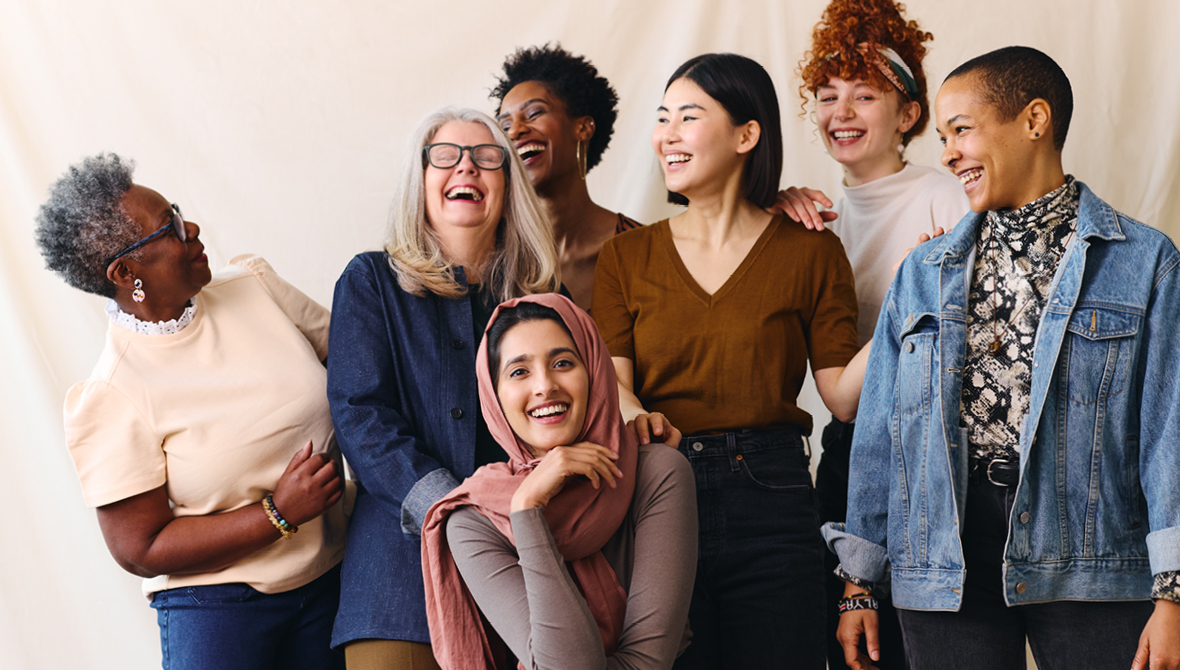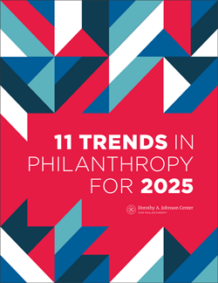Collective Giving Projected to Double in the Next Five Years


 This article was first published in our 11 Trends in Philanthropy for 2025 report. Explore the full report here.
This article was first published in our 11 Trends in Philanthropy for 2025 report. Explore the full report here.
Want the latest trends, research, and more delivered right to your inbox? Subscribe to the Johnson Center email newsletter.
Long before institutional philanthropy emerged in the 19th and 20th centuries, informal — and no less deeply meaningful — forms of cooperative philanthropy pervaded cultures and communities around the world. “From tandas in Mexico to gehs in Korea and sou sous in West African countries, the collective giving model has historically served as a cornerstone of community generosity, supporting family, friends, and the community itself” (Loson-Ceballos & Layton, 2024, p. 1).
Studies show that, since the turn of the 21st century especially, communities and networks across the U.S. have embraced collective giving (groups are often called “giving circles”) and added formal structures and a sense of group identity to this practice. Now, recent research from Adriana Loson-Ceballos, Ph.D., and myself (2024) reveals collective giving’s striking momentum.
Our findings — published in In Abundance: An Analysis of the Thriving Landscape of Collective Giving in the U.S. — are decisive: between 2017 and 2023, nearly 4,000 collective giving groups mobilized approximately 370,000 philanthropists to donate more than $3.1 billion — indicating more than 140% growth in both participation and total monetary donations across the movement since the most recent previous landscape survey was published in 2017.
What’s more, based on our findings, we can reasonably project that the collective giving movement is on a path to double again in the next five years — effectively making collective giving, as termed by Barron’s (Serwer, 2024), “the Fast Track of Philanthropy.”
Researchers first began to focus on giving circles in the early 2000s (Shaw-Hardy, 2000, 2005; Rutnik & Bearman, 2005; Eikenberry, 2007). Sondra Shaw-Hardy’s work to trace the rise of the women’s philanthropy movement, specifically, points to some baseline data for the field. She noted in 2005, for instance,
It has been estimated that more than two hundred types of women’s giving circles now exist throughout the United States, most organized since 2000. Other forms of giving circles include the more than sixty United Way Women’s Initiatives that have been formed since 2002 … and the Impact 100 groups that also began in 2002 … (p. 14)
In 2007, Angela Eikenberry reported that United Philanthropy Forum (formerly known as the Forum of Regional Associations of Grantmakers) “had listed nearly 600 giving circles in the United States, Canada, Japan, the United Kingdom, and elsewhere. There is strong indication that many more exist and will continue to emerge” (p. 251).
A decade later, Eikenberry and colleagues — including Dr. Jason Franklin, the first W.K. Kellogg Community Philanthropy Chair at the Johnson Center, who first wrote in 2018 about the rise of the collective giving movement in 11 Trends in Philanthropy for 2018 — formed the Collective Giving Research Group. Their 2017 report, The Landscape of Giving Circles/Collective Giving Groups in the U.S., established the trajectory of the movement (Bearman et al.). They found that more than 150,000 people within 1,600 groups had participated in collective giving, jointly moving $1.29 billion into communities across the country since their inception.
That research led directly to the creation of Philanthropy Together in 2020 (n.d.; Krause, 2021), an infrastructure organization dedicated to elevating, supporting, and championing the collective giving movement. From there, Philanthropy Together went on to launch the first-ever Global Giving Circle Directory in partnership with Grapevine.
Philanthropy Together’s broad-based support in the sector (the organization was co-designed in structure and mission by individuals from the Asian Women Giving Circle, Amplifier, Community Investment Network, Latino Community Foundation, and Philanos, with input from over 100 others [Krause, 2021]), and the broad public appeal of collective giving (Executive Director Sara Lomelin’s [2022] TED Talk on collective giving has reached over 1.4 million views as of May 2024) are markers of the vehicle’s increasing familiarity and popularity.
Beyond its overall quantitative growth, In Abundance shows how collective giving is also diversifying the philanthropic landscape by increasingly engaging marginalized communities and challenging the stereotype of the wealthy white male philanthropist (Loson-Ceballos & Layton, 2024):
“From 2016 to 2019, 17% of the respondents who joined a giving circle identified as a person of color: from 2020 to 2023, the percentage rose to 27%, an increase of nearly 60%” (p. 22).
Women’s leadership and participation rates dominate the movement:
The percentage of groups composed entirely of women was found to be 53% in 2006 (Bearman, 2007), 53% in 2016 (Eikenberry et al., 2017), and 60% in 2023.
Importantly for its current and future impact on communities, findings from In Abundance also showed how collective giving groups increasingly prioritize equity and inclusivity — 60% “reported an explicit commitment to addressing racial and ethnic equity as fundamental to their groups’ approach to giving” (Loson-Ceballos & Layton, 2024, p. 32) — and how this practice broadens the definition of philanthropy to include contributions of time, talent, testimony, and ties, alongside treasure (or financial donations). A substantial portion of respondents reported supporting nonprofit grantees with more than money.
Given the diversity of collective giving’s global roots, it is also worth noting that giving circles are not merely a U.S.-based phenomenon. In 2015, Eikenberry and Breeze found 80 giving circles active in the U.K. and Ireland. Research from Franklin and Bearman (2021) projected that there were at least 426 giving circles outside of the U.S. in 2018, and that they collectively moved over $45 million (in U.S. dollars) that year. Updated data for the international giving circle movement is not available, but the rapid rise of U.S.-based circles indicates there is likely a parallel rise going on globally, even if we cannot yet estimate how closely that growth might mirror U.S. trends.
For its hundreds of thousands of participants, collective giving ultimately represents more than a means of moving money. Their participation unites individuals through their shared generosity. It embodies a vision for a connected, compassionate, and empowered society, capable of effecting positive change in communities. In its abundance, collective giving has already begun to reweave the tattered social fabric of our country, signaling a promising future for philanthropy and civic engagement alike.
Bearman, J. E. (2007). More giving together: The growth and impact of giving circles and shared giving. Forum of Regional Associations of Grantmakers. https://philanos.org/resources/Documents/FY24/More%20Giving%20Together-%20The%20Growth%20and%20Impact%20of%20Giving%20Circles%20and%20Shared%20Giving.pdf
Bearman, J., Carboni, J., Eikenberry, A., & Franklin, J. (2017, November). The landscape of giving circles/collective giving groups in the U.S. Collective Giving Research Group. https://johnsoncenter.org/wp-content/uploads/2020/10/Giving-Circles-Research-Full-Report-WEB.pdf
Eikenberry, A. M. (2007). Giving circles: Self-help/mutual aid, community philanthropy, or both? International Journal of Self-Help and Self-Care, 5(3). https://doi.org/10.2190/sh.5.3.d
Eikenberry, A., & Breeze, B. (2015, February). Growing philanthropy through collaboration: The landscape of giving circles in the United Kingdom and Ireland. Voluntary Sector Review, 6(1). https://doi.org/10.1332/204080515X14241771107299
Franklin, J. (2018, January 15). Giving more by giving together. 11 Trends in Philanthropy for 2018. Dorothy A. Johnson Center for Philanthropy at Grand Valley State University. https://johnsoncenter.org/blog/giving-more-by-giving-together/
Franklin, J., & Bearman, J. (2021). Global giving circles. Dorothy A. Johnson Center for Philanthropy at Grand Valley State University. https://johnsoncenter.org/wp-content/uploads/2021/01/Giving-Circles-Webinar-Presentation.pdf
Independent Sector. (2017, August 31). Becoming United Philanthropy Forum with David Biemesderfer. https://independentsector.org/blog/becoming-united-philanthropy-forum-with-david-biemesderfer/
Krause, I. (2021, March 9). How a study on giving circles led to the launch of Philanthropy Together. Dorothy A. Johnson Center for Philanthropy at Grand Valley State University. https://johnsoncenter.org/blog/how-a-study-on-giving-circles-led-to-the-launch-of-philanthropy-together/
Lomelin, S. (2022, April). Your invitation to disrupt philanthropy [Video]. TED Conferences. https://www.ted.com/talks/sara_lomelin_your_invitation_to_disrupt_philanthropy
Loson-Ceballos, A., & Layton, M. D. (2024). In abundance: An analysis of the thriving landscape of collective giving in the U.S. Dorothy A. Johnson Center for Philanthropy at Grand Valley State University and Philanthropy Together. https://johnsoncenter.org/wp-content/uploads/2024/04/in-abundance-an-analysis-of-the-thriving-landscape-of-collective-giving-in-the-u-s.pdf
Philanthropy Together. (n.d.) About us. Our story. The history. https://philanthropytogether.org/about/
Rutnik, T. A., & Bearman, J. (2005). Giving together: A national scan of giving circles and shared giving: The guidebook to giving circles. Forum of Regional Associations of Grantmakers.
Shaw-Hardy, S. (2000) Creating a women’s giving circle: A handbook. Women’s Philanthropy Institute, Indiana University.
Shaw-Hardy, S. (2005, Winter). The emergence and future of the modern women’s philanthropy movement. New Directions for Philanthropic Fundraising, 50, 11–22. https://doi.org/10.1002/pf.125